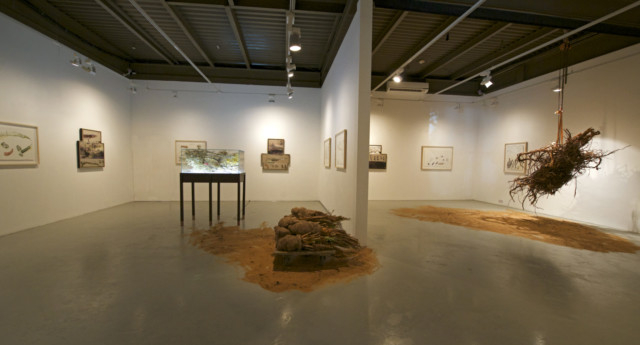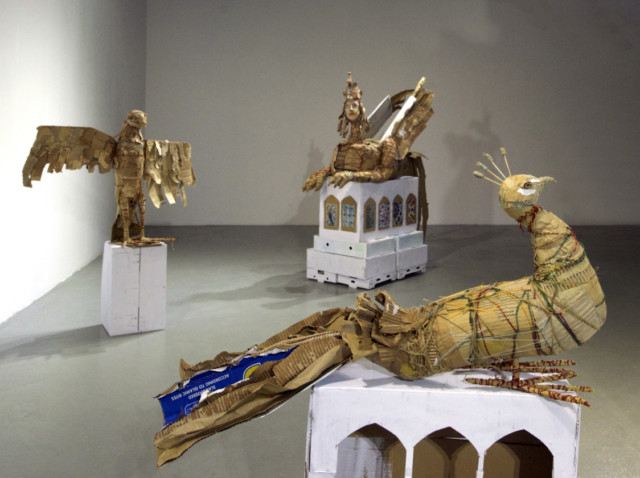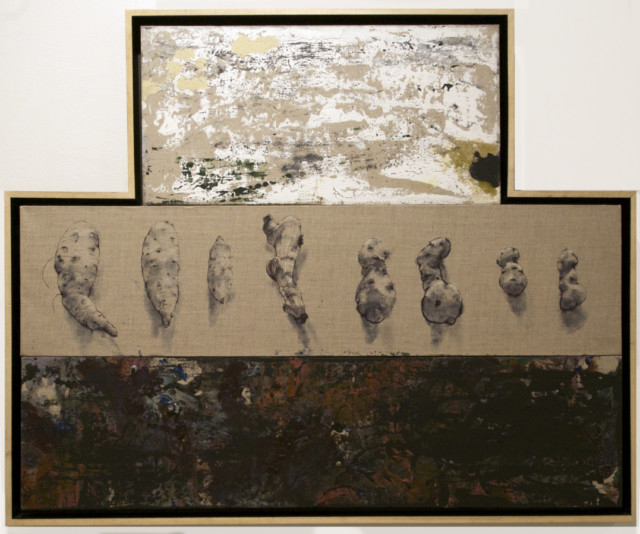
“Roots”, a joint exhibition by Iranian artists Shaqayeq Arabi and Fereydoun Ave, is about the beauty of nature and about respecting mother Earth. The two artists, based in Dubai and Paris respectively, have explored different aspects of this theme in their own unique ways. Arabi has used found materials to create installations that speak of the destruction of our environment whereas Ave reflects on the cycle of energy and life in nature through his mixed-media paintings.
Arabi’s studio is filled with a variety of materials that she picks up from the streets in Dubai. “I never know why I am attracted to these objects. But when I start working, these things find their place in my installations, and the reason why I subconsciously picked them up becomes clear,” she says.
The concept for this show was inspired by some uprooted bushes that she found lying by the side of a road. She brought them to her studio, covered them with a layer of wax and is presenting them in an illuminated glass case. Objects such as rags, wires and rope can be seen entwined in the dead branches and roots. And the artist has added pieces of paper torn out from a book of poems by Pablo Neruda.
“Uprooted plants, covered with all kinds of rubbish, are a common sight in urban areas where new construction is taking place. They speak of growing urbanisation, increasing pollution and our lack of regard for mother Earth. I used Neruda’s poem ‘Memories within me’ in this work because these bushes carry a lot of memories within them. Covering the dead bushes with a layer of wax and putting them in a glass case expresses my desire to preserve nature, which is so precious,” she says.
In other installations, Arabi has used palm saplings, and roots and trunks of palm trees that were uprooted to make way for new roads and buildings. The gnarled roots are suspended from the ceiling as a stark reminder of their cruel separation from the earth, and of the growing distance between human beings and nature. The installations compel viewers to appreciate the beauty of nature as well as to think deeply about our relationship with it.
Ave’s series of mixed-media paintings on paper and canvas, titled “Winter Roots”, also contemplates our relationship with nature. It features realistic illustrations of various root vegetables. Many of the paintings are split into horizontal sections, with each individual canvas representing different strata of soil and the roots placed in the lower layers. “In winter we usually feel low in energy, and this can lead to depression. But I decided to use this in a creative way by making very realistic paintings of the different types of roots I was eating in winter. The process helped me to understand that energy cycles change with the seasons; and in winter energy becomes subterranean, and gets concentrated in the roots, cocooned deep inside the womb of the Earth, to burst forth once again in the spring,” Ave says.
“Roots” will run at The In Between Space at Courtyard until December 4.
Box:
Conference of the Birds
By Jyoti Kalsi
Yasmin Sinai is constantly looking for ways to make art simple and accessible to everybody. In her latest show, “Conference of the Birds” the Dubai-based artist of Iranian and Hungarian origin has used recycled cardboard, a needle and thread to create beautiful sculptures of a variety of birds. Sinai is also conducting workshops to teach this technique to all art lovers.
The show is inspired by Persian poet Farid-ud-din Attar’s famous poem, “The Conference of the Birds”. The poem tells the story of all the birds in the world gathering to decide who should be their king. They decided to find the legendary Simorgh, a mythical Phoenix-like bird that lives on top of the Qaf mountain. Only 30 birds managed to complete the long and difficult journey. But all they found was a lake, in which they saw their own reflections.
The story, which plays with the dual meaning of Simorgh — the legendary bird and si morgh, which means 30 birds — is profoundly spiritual. Each bird in the story represents a human failing that prevents human beings from attaining enlightenment. And their journey involves crossing seven valleys that represent the different stages that, according to Sufi philosophy, one must traverse to realise the true nature of god. The 30 birds that completed this journey thus realised that the Simurgh or god resides within them and is reflected in the totality of existence.
“I have recently moved to Dubai and saw a hoopoe for the first time. I really liked this bird and it was the first one I made in this series. I was really excited to find out that in Attar’s story, the hoopoe was the leader of the birds. I have made 15 of the 30 birds that completed the journey, and the remaining 15 will be made by my students in the workshops,” Sinai says.
The birds include an owl, a rooster, a stork, playful parrots, a peacock and a Simorgh, depicted as a creature with a human head, body of a bird and a lion’s feet. Instead of paint Sinai has used coloured cardboard and paper to create the feathers, crests and tails of the birds; and rather than using glue, she has sown together the cardboard pieces with coloured thread. The birds are all perched atop stacks of shoe-boxes that have been painted white and decorated with cut-outs of traditional decorations found in Persian mosques.
“I have tried to reflect the spiritual soul in these ordinary birds,” Sinai says. “And the stitches on the sculptures represent all of us. In our lives we go through a lot of pain and sorrow, but we try to stitch ourselves together and carry on,” she adds.
The show will run at Total Arts at Courtyard until December 4.














